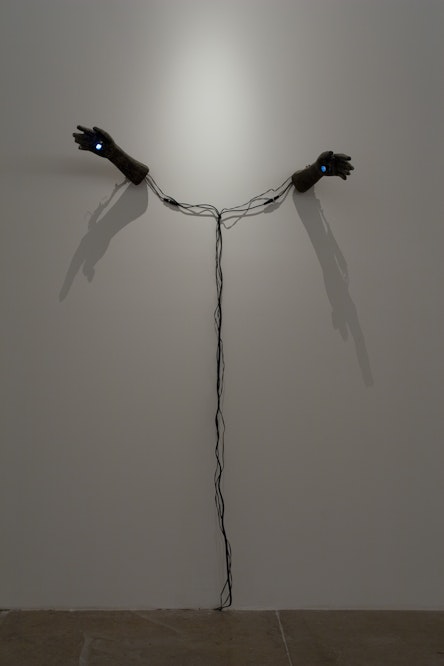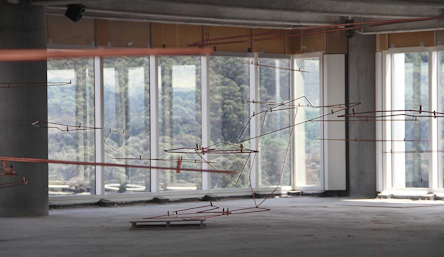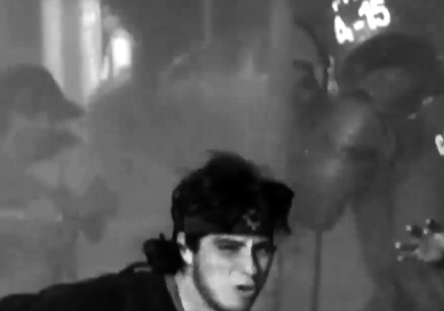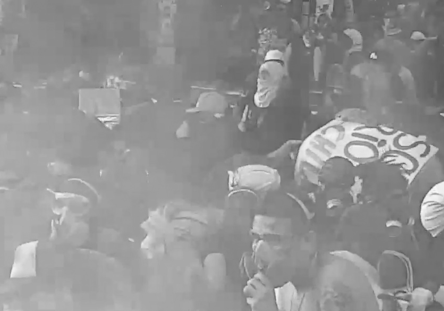
Rolf Art's exhibition proposal reveals the possibilities of interaction and exchange between the language of audiovisual, technological and performative arts by four remarkable Latin American artists: José Alejandro Restrepo (1959, Colombia), forefather of video art and audiovisual installation in Latin America; María José Arjona (1973, Colombia), one of the most outstanding contemporary performers in Colombia and the region; Andrés Denegri (1975, Argentina), a young visual artist with an important career in the field of contemporary audiovisual: expanded cinema; and Gabriela Golder (1971, Argentina), an Argentine artist who is a reference in video art at both local and international scene.
The project offers different approaches to the moving image through a selection of works that deal with political, social, religious and metaphysical aspects from our region: Restrepo presents a video-installation that, through a post-religious position, critically evokes our media mysticism; the intersection between video and performance is explored by Arjona in a piece where the artist surrenders oneself to the forces of the supra-sensorial, in order to enter in composition with other logics of existence; the film installation is approached in a disruptive way by Denegri through a large-format piece where the complex machinery projects archive images to reflect on the political perspectives of the 20th century; and finally, the single-channel video is displayed on the visual arts space by Golder's work which delves into the unresolved social conflicts of our contemporaneity.
Rolf Art, located in Buenos Aires and founded by Florencia Giordana Braun in 2009, is the only art gallery specialized in technical image in Argentina. Focused on contemporary Latin American visual arts, the gallery features works exploring photographic media and its boundaries. The selection of artworks considers pieces with an inextricable union between critical density and aesthetic value. The curatorial profile challenges the political context & considers the social and economical background of artistic production as a determining factor for art’s interpretation. We are committed to a select group of contemporary established Latin American artists, promoting them on a national and international basis. We support their artistic production together with editorial and audiovisual projects.
In order to contribute to the production and appreciation of contemporary art, looking forward to pushing the boundaries of the Latin American visual arts, the gallery develops an important exhibition and educational program. Working alongside leading researchers, curators, and art critics, the gallery organizes exhibitions in collaboration with national and international institutions & photo festivals; leading the way towards a sustained participation in the most important art & photo fairs worldwide; managing the incorporation of Latin American artists in renowned institutions; in addition to multiple private collections; contributing to the legitimation of the visual expressions from the Latin American region worldwide.

José Alejandro Restrepo is a central figure in Latin American contemporary art, with more than thirty years of production within the historical panorama of electronic arts in our continent. His training and interests are varied and range from the visual and performing arts, installation, photography, performance and editorial production, establishing himself as a model of contemporary artist who operates from hybridity. His work is based on serious research on the speeches of the dominant power and popular beliefs that derive in a critical vision and whose interpretations dismantle the ideology of the system. The recovery of the theatricality of Catholicism and the codes of the colonial baroque by the political / media and the slide towards politics of some of the most important religious themes, such as punishment, redemption and sacrifice (as legitimization of violence), occupy a central role in the artist’s work. A pioneer of video art, Restrepo puts the documentary image in dialogue through a work exhibited under several formats and devices, using the resources of video technology and electronic image to accentuate a deviation from the discourses of the entertainment and the mainstream of contemporary art. In order to do this, the artist often resorts to the re-appropriation of television images and their manipulation, reconstructing the messages of the mass media to highlight the value given to images. Some of his most outstanding works are “Pavements”, “The pass of Quindío I”, “Paradisiacal Muse” and “Iconomia “.

José Alejandro Restrepo is a central figure in Latin American contemporary art, with more than thirty years of production within the historical panorama of electronic arts in our continent. His training and interests are varied and range from the visual and performing arts, installation, photography, performance and editorial production, establishing himself as a model of contemporary artist who operates from hybridity. His work is based on serious research on the speeches of the dominant power and popular beliefs that derive in a critical vision and whose interpretations dismantle the ideology of the system. The recovery of the theatricality of Catholicism and the codes of the colonial baroque by the political / media and the slide towards politics of some of the most important religious themes, such as punishment, redemption and sacrifice (as legitimization of violence), occupy a central role in the artist’s work. A pioneer of video art, Restrepo puts the documentary image in dialogue through a work exhibited under several formats and devices, using the resources of video technology and electronic image to accentuate a deviation from the discourses of the entertainment and the mainstream of contemporary art. In order to do this, the artist often resorts to the re-appropriation of television images and their manipulation, reconstructing the messages of the mass media to highlight the value given to images. Some of his most outstanding works are “Pavements”, “The pass of Quindío I”, “Paradisiacal Muse” and “Iconomia “.

José Alejandro Restrepo is a central figure in Latin American contemporary art, with more than thirty years of production within the historical panorama of electronic arts in our continent. His training and interests are varied and range from the visual and performing arts, installation, photography, performance and editorial production, establishing himself as a model of contemporary artist who operates from hybridity. His work is based on serious research on the speeches of the dominant power and popular beliefs that derive in a critical vision and whose interpretations dismantle the ideology of the system. The recovery of the theatricality of Catholicism and the codes of the colonial baroque by the political / media and the slide towards politics of some of the most important religious themes, such as punishment, redemption and sacrifice (as legitimization of violence), occupy a central role in the artist’s work. A pioneer of video art, Restrepo puts the documentary image in dialogue through a work exhibited under several formats and devices, using the resources of video technology and electronic image to accentuate a deviation from the discourses of the entertainment and the mainstream of contemporary art. In order to do this, the artist often resorts to the re-appropriation of television images and their manipulation, reconstructing the messages of the mass media to highlight the value given to images. Some of his most outstanding works are “Pavements”, “The pass of Quindío I”, “Paradisiacal Muse” and “Iconomia “.

Artist focused on performance, María José Arjona plans to rethink the roles of the movement of matter in space, time, and the duration of that interaction, assuming a perspective that proposes to develop negotiation maneuvers where research and writing are the experimental spaces to develop the reflection. Her work insists on confronting the system, transforming itself into a fundamental tool of provocation and connection with the other, each piece being a set of poetic and choreographic strategies where bodies are the link and the battlefield capable of materializing the repercussions of the clash of forces between them and with the objects that also inhabit the same space, stimulating and transforming themselves in this dynamic. Gestures as a clear manifestation of feelings, needs, states of mind, are an invaluable source for the artist who finds in them a kind of archive that collects and registers emotions within political and social power structures, applying an acute point of view that contemplates philosophical readings in order to emphasize their interest in transition, transformation and becoming as actions of resistance. In her series “White (IN-TRANSIT BERLIN 2009)”, “Vires” (2010), “All the others in me” (2012) and “Lifeline” (2016), Arjona displays a range of performance proposals where the body is always in the center of the scene, though as a vehicle not only for denouncing violence and socio-political problems, but as a promoter of alternative ways of thinking about them, the body as a means of rethinking communication and lack of communication, the messages given for granted, the lack of questioning about thoughts that are given to us and we naturalize without opposing debate. In Arjona’s work, the viewer is invited to assume a physical and intellectual active role.

Artist focused on performance, María José Arjona plans to rethink the roles of the movement of matter in space, time, and the duration of that interaction, assuming a perspective that proposes to develop negotiation maneuvers where research and writing are the experimental spaces to develop the reflection. Her work insists on confronting the system, transforming itself into a fundamental tool of provocation and connection with the other, each piece being a set of poetic and choreographic strategies where bodies are the link and the battlefield capable of materializing the repercussions of the clash of forces between them and with the objects that also inhabit the same space, stimulating and transforming themselves in this dynamic. Gestures as a clear manifestation of feelings, needs, states of mind, are an invaluable source for the artist who finds in them a kind of archive that collects and registers emotions within political and social power structures, applying an acute point of view that contemplates philosophical readings in order to emphasize their interest in transition, transformation and becoming as actions of resistance. In her series “White (IN-TRANSIT BERLIN 2009)”, “Vires” (2010), “All the others in me” (2012) and “Lifeline” (2016), Arjona displays a range of performance proposals where the body is always in the center of the scene, though as a vehicle not only for denouncing violence and socio-political problems, but as a promoter of alternative ways of thinking about them, the body as a means of rethinking communication and lack of communication, the messages given for granted, the lack of questioning about thoughts that are given to us and we naturalize without opposing debate. In Arjona’s work, the viewer is invited to assume a physical and intellectual active role.

Artist focused on performance, María José Arjona plans to rethink the roles of the movement of matter in space, time, and the duration of that interaction, assuming a perspective that proposes to develop negotiation maneuvers where research and writing are the experimental spaces to develop the reflection. Her work insists on confronting the system, transforming itself into a fundamental tool of provocation and connection with the other, each piece being a set of poetic and choreographic strategies where bodies are the link and the battlefield capable of materializing the repercussions of the clash of forces between them and with the objects that also inhabit the same space, stimulating and transforming themselves in this dynamic. Gestures as a clear manifestation of feelings, needs, states of mind, are an invaluable source for the artist who finds in them a kind of archive that collects and registers emotions within political and social power structures, applying an acute point of view that contemplates philosophical readings in order to emphasize their interest in transition, transformation and becoming as actions of resistance. In her series “White (IN-TRANSIT BERLIN 2009)”, “Vires” (2010), “All the others in me” (2012) and “Lifeline” (2016), Arjona displays a range of performance proposals where the body is always in the center of the scene, though as a vehicle not only for denouncing violence and socio-political problems, but as a promoter of alternative ways of thinking about them, the body as a means of rethinking communication and lack of communication, the messages given for granted, the lack of questioning about thoughts that are given to us and we naturalize without opposing debate. In Arjona’s work, the viewer is invited to assume a physical and intellectual active role.

Andrés Denegri approaches the visual arts combining film, video, installations and photography. His projects generate dialogues between different formats, addressing them poetically and conceptually, creating tension in the classic uses of audiovisual technologies. His photographic production has its origins in analog cinema as the artist uses sequences of 16mm or Super 8 film frames to generate still images. Vintage film projectors are the protagonists of many of Denegri’s installations: from portable family devices to powerful industrial machines that are combined in the production of kinetic objects and monumental screens where celluloid leaves the projector and travels through the space traveled by the viewer. His cinematographic gaze allows the artist to create works thought as sequences, images that operate as registers where dialogues between cinema, literature and photography are proposed but where each practice maintains its support, its language, without invading the terrain of the other. Some of his most outstanding works such as “Instante Bony” (2000), “Tomar las calles” (2019) and “Máquinas de lo sensible (2019)” deal with research in the field of audiovisual arts and experimental cinema as well as study of material from historical archives. Denegri produces works where the devices and the memory technology are transformed into an allegory of the processes of forgetting and the denial of history, inviting the viewer to rethink the relationship between memory and its active importance in our present.

Andrés Denegri approaches the visual arts combining film, video, installations and photography. His projects generate dialogues between different formats, addressing them poetically and conceptually, creating tension in the classic uses of audiovisual technologies. His photographic production has its origins in analog cinema as the artist uses sequences of 16mm or Super 8 film frames to generate still images. Vintage film projectors are the protagonists of many of Denegri’s installations: from portable family devices to powerful industrial machines that are combined in the production of kinetic objects and monumental screens where celluloid leaves the projector and travels through the space traveled by the viewer. His cinematographic gaze allows the artist to create works thought as sequences, images that operate as registers where dialogues between cinema, literature and photography are proposed but where each practice maintains its support, its language, without invading the terrain of the other. Some of his most outstanding works such as “Instante Bony” (2000), “Tomar las calles” (2019) and “Máquinas de lo sensible (2019)” deal with research in the field of audiovisual arts and experimental cinema as well as study of material from historical archives. Denegri produces works where the devices and the memory technology are transformed into an allegory of the processes of forgetting and the denial of history, inviting the viewer to rethink the relationship between memory and its active importance in our present.

Andrés Denegri approaches the visual arts combining film, video, installations and photography. His projects generate dialogues between different formats, addressing them poetically and conceptually, creating tension in the classic uses of audiovisual technologies. His photographic production has its origins in analog cinema as the artist uses sequences of 16mm or Super 8 film frames to generate still images. Vintage film projectors are the protagonists of many of Denegri’s installations: from portable family devices to powerful industrial machines that are combined in the production of kinetic objects and monumental screens where celluloid leaves the projector and travels through the space traveled by the viewer. His cinematographic gaze allows the artist to create works thought as sequences, images that operate as registers where dialogues between cinema, literature and photography are proposed but where each practice maintains its support, its language, without invading the terrain of the other. Some of his most outstanding works such as “Instante Bony” (2000), “Tomar las calles” (2019) and “Máquinas de lo sensible (2019)” deal with research in the field of audiovisual arts and experimental cinema as well as study of material from historical archives. Denegri produces works where the devices and the memory technology are transformed into an allegory of the processes of forgetting and the denial of history, inviting the viewer to rethink the relationship between memory and its active importance in our present.

A visual artist, curator and professor of Experimental Video and New Media in Argentina and abroad, Golder is the co-director of both the Bienal de la Imagen en Movimiento (BIM) and CONTINENTE, Research Center in Audiovisual Arts, at the Universidad Nacional de Tres de Febrero, in Argentina. She also serves as curator of the Experimental Video and Film Program of the Modern Art Museum in Buenos Aires. She is a professor in the Department of Electronic Arts and in the Masters program of Technology and Aesthetics of Electronic Arts at the National University of Tres de Febrero, the Universidad del Cine in Buenos Aires, and the Universidad Maimonides. Using the formats of film, video and installations, her works primarily raise issues of memory, identity and the world of labour. She was artist in residence at the Banff Centre for the Arts, Canada; the CICV, France; the Kunsthochschule für Medien, Germany; Schloss, Balmoral, Germany; Wexner Center for the Arts, United States; UQAM, Montréal, Canada, Chambre Blanche, Québec, Canada, RBHA, Sao Paulo, Brazil and Le 104, Paris, France. She received several awards for her work, among others: Estado da Arte, en la 21a Bienal de Arte Contemporánea Sesc_Videobrasil (2019); BA Site Specific 2014; National Fund for the Arts (group projects), Argentina (2015) ; Luis Espinal-Mostra CineTrabalho Award, Brazil (2011); the "Sigwart Blum Award“ of the Argentinean Arts Critics Association, Argentina (2007); Media Art Award from the ZKM, Germany (2004); the first prize of the Salón Nacional de Artes Visuales, Argentina (2004); the first prize at Videobrasil, Brazil (2003); the first prize at Festival Videoformes, France (2003) and the Tokyo Video Award, in Japan (2002). She received several grants, among others: Group project at Fondo Nacional de las Artes. Argentina (2014); Ars Electronica, 80+1 Project (for ARRORRÓ project). Linz, Austria (2014); Fondo CulturaBA. Buenos Aires. Argentina (2006); Secretaría de Cultura de la Nación – Wexner Center for the Arts, EEUU (2005); Jan Vrijman Fund, Holland (2004); Fellow Academy of Media Art, Köln, Germany, (2003); French Gouvernment / Fondo Nacional de las Artes (1999); Banff Centre for the Arts, Alberta, Canada (1998); Instituto de Cooperación Iberoamericana, España (1997); École Régionale de Beaux-Arts de Rennes, Francia (1995); Fondo Nacional de las Artes, Argentina (1995).

A visual artist, curator and professor of Experimental Video and New Media in Argentina and abroad, Golder is the co-director of both the Bienal de la Imagen en Movimiento (BIM) and CONTINENTE, Research Center in Audiovisual Arts, at the Universidad Nacional de Tres de Febrero, in Argentina. She also serves as curator of the Experimental Video and Film Program of the Modern Art Museum in Buenos Aires. She is a professor in the Department of Electronic Arts and in the Masters program of Technology and Aesthetics of Electronic Arts at the National University of Tres de Febrero, the Universidad del Cine in Buenos Aires, and the Universidad Maimonides. Using the formats of film, video and installations, her works primarily raise issues of memory, identity and the world of labour. She was artist in residence at the Banff Centre for the Arts, Canada; the CICV, France; the Kunsthochschule für Medien, Germany; Schloss, Balmoral, Germany; Wexner Center for the Arts, United States; UQAM, Montréal, Canada, Chambre Blanche, Québec, Canada, RBHA, Sao Paulo, Brazil and Le 104, Paris, France. She received several awards for her work, among others: Estado da Arte, en la 21a Bienal de Arte Contemporánea Sesc_Videobrasil (2019); BA Site Specific 2014; National Fund for the Arts (group projects), Argentina (2015) ; Luis Espinal-Mostra CineTrabalho Award, Brazil (2011); the "Sigwart Blum Award“ of the Argentinean Arts Critics Association, Argentina (2007); Media Art Award from the ZKM, Germany (2004); the first prize of the Salón Nacional de Artes Visuales, Argentina (2004); the first prize at Videobrasil, Brazil (2003); the first prize at Festival Videoformes, France (2003) and the Tokyo Video Award, in Japan (2002). She received several grants, among others: Group project at Fondo Nacional de las Artes. Argentina (2014); Ars Electronica, 80+1 Project (for ARRORRÓ project). Linz, Austria (2014); Fondo CulturaBA. Buenos Aires. Argentina (2006); Secretaría de Cultura de la Nación – Wexner Center for the Arts, EEUU (2005); Jan Vrijman Fund, Holland (2004); Fellow Academy of Media Art, Köln, Germany, (2003); French Gouvernment / Fondo Nacional de las Artes (1999); Banff Centre for the Arts, Alberta, Canada (1998); Instituto de Cooperación Iberoamericana, España (1997); École Régionale de Beaux-Arts de Rennes, Francia (1995); Fondo Nacional de las Artes, Argentina (1995).

A visual artist, curator and professor of Experimental Video and New Media in Argentina and abroad, Golder is the co-director of both the Bienal de la Imagen en Movimiento (BIM) and CONTINENTE, Research Center in Audiovisual Arts, at the Universidad Nacional de Tres de Febrero, in Argentina. She also serves as curator of the Experimental Video and Film Program of the Modern Art Museum in Buenos Aires. She is a professor in the Department of Electronic Arts and in the Masters program of Technology and Aesthetics of Electronic Arts at the National University of Tres de Febrero, the Universidad del Cine in Buenos Aires, and the Universidad Maimonides. Using the formats of film, video and installations, her works primarily raise issues of memory, identity and the world of labour. She was artist in residence at the Banff Centre for the Arts, Canada; the CICV, France; the Kunsthochschule für Medien, Germany; Schloss, Balmoral, Germany; Wexner Center for the Arts, United States; UQAM, Montréal, Canada, Chambre Blanche, Québec, Canada, RBHA, Sao Paulo, Brazil and Le 104, Paris, France. She received several awards for her work, among others: Estado da Arte, en la 21a Bienal de Arte Contemporánea Sesc_Videobrasil (2019); BA Site Specific 2014; National Fund for the Arts (group projects), Argentina (2015) ; Luis Espinal-Mostra CineTrabalho Award, Brazil (2011); the "Sigwart Blum Award“ of the Argentinean Arts Critics Association, Argentina (2007); Media Art Award from the ZKM, Germany (2004); the first prize of the Salón Nacional de Artes Visuales, Argentina (2004); the first prize at Videobrasil, Brazil (2003); the first prize at Festival Videoformes, France (2003) and the Tokyo Video Award, in Japan (2002). She received several grants, among others: Group project at Fondo Nacional de las Artes. Argentina (2014); Ars Electronica, 80+1 Project (for ARRORRÓ project). Linz, Austria (2014); Fondo CulturaBA. Buenos Aires. Argentina (2006); Secretaría de Cultura de la Nación – Wexner Center for the Arts, EEUU (2005); Jan Vrijman Fund, Holland (2004); Fellow Academy of Media Art, Köln, Germany, (2003); French Gouvernment / Fondo Nacional de las Artes (1999); Banff Centre for the Arts, Alberta, Canada (1998); Instituto de Cooperación Iberoamericana, España (1997); École Régionale de Beaux-Arts de Rennes, Francia (1995); Fondo Nacional de las Artes, Argentina (1995).